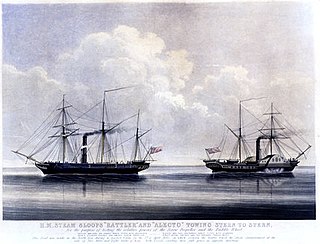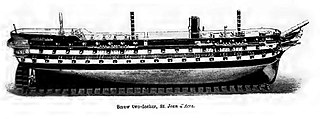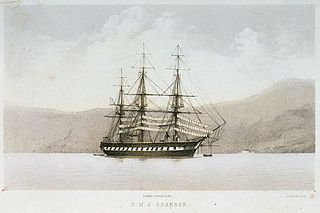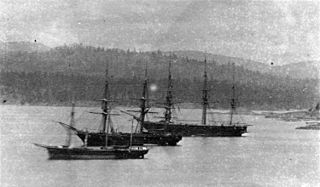Seven vessels of the British Royal Navy have borne the name HMS Amphion, after the Greek hero Amphion.

HMS Rattler was a 9-gun steam screw sloop of the Royal Navy, and one of the first British warships to be completed with screw propulsion. She was originally ordered as a paddle wheel 4-gun steam vessel from Sheerness Dockyard on 12 March 1841. She was reordered on 24 February 1842 as a propeller type 9-gun sloop from HM Royal Dockyard, Sheerness, as a new vessel. William Symonds had redesigned the ship as a screw propeller driven vessel.

HMS Miranda was a 14-gun wooden screw sloop of the Royal Navy. As part of the 1847 Program, she was designed by John Fincham, Master Shipwright of Portsmouth ,and is considered an improved Rattler, with the design approved on 3 November 1847. She was ordered on 25 April 1847 with the name Grinder from Royal Dockyard, Sheerness. On 3 November 1847, she was reordered as Miranda from Sheerness Dockyard. Launched in 1851, she was completed to see action in the Crimean War. In 1854 she was in the White Sea and participated in the bombardment of the Port of Kola. She then served in the Sea of Azov during 1855. Two of her crew were awarded the Victoria Cross for their bravery. Towards the end of her career she transported troops during the New Zealand Wars. She was reclassified as a corvette by 1862. She was sold for breaking in December 1869.
HMS Highflyer was a 21-gun wooden screw frigate of the Royal Navy. She was built on the River Thames by C J Mare and launched on 13 August 1851. She spent twenty years in service, including action in the Crimean War and the Second Opium War, before being broken up at Portsmouth in May 1871.

The third HMS Dauntless was a wooden-hulled steam screw frigate, launched at Portsmouth in 1847.

HMS Avenger was a wooden paddle wheel frigate of the Royal Navy launched in 1845 and wrecked with heavy loss of life in 1847.

HMS Exmouth was a 91-gun screw propelled Albion-class second-rate ship of the line of the Royal Navy.

HMS Sans Pareil was a 70-gun screw propelled ship of the line of the Royal Navy.

HMS Victor Emmanuel was a screw-propelled 91-gun second-rate ship of the line of the Royal Navy, originally launched as HMS Repulse, but renamed shortly after being launched.

HMS Conqueror was a 101-gun Conqueror-class screw-propelled first-rate ship of the line of the Royal Navy. She was launched in 1855, but spent only six years in service before being wrecked on Rum Cay in what was then the colony of the Bahamas in 1861.

HMS St Jean d'Acre was the Royal Navy's first 101 gun screw two-decker line-of-battle ship. She served in the Crimean War.

HMS James Watt was a 91-gun steam and sail-powered second rate ship of the line. She had originally been ordered as one of a two ship class, with her sister HMS Cressy, under the name HMS Audacious. She was renamed on 18 November 1847 in honour of James Watt, the purported inventor of the steam engine. She was the only Royal Navy ship to bear this name. Both ships were reordered as screw propelled ships, James Watt in 1849, and Cressy in 1852. James Watt became one of the four-ship Agamemnon-class of ships of the line. They were initially planned as 80-gun ships, but the first two ships built to the design, HMS Agamemnon and James Watt, were rerated on 26 March 1851 to 91 guns ships, later followed by the remainder of the class.

HMS Shannon was a Liffey-class steam frigate of the Royal Navy.

HMS Malacca was a 17-gun wooden sloop of the Royal Navy. She was ordered on 9 November 1847 from Moulmein, Burma to be built of teak. As a Surveyor's Department design, Malacca was based on the Conflict designed sloop which was approved on 9 December 1848. After launching in April 1853 she was commissioned the following month to be sailed to England for the fitting of her engine. She entered British Naval service in 1854 and served three commissions including action in the Russian War 1854 - 55 before being sold in 1869. Her resale to Japan, she served in the Japanese Navy as a training ship until broken in 1906.

The Albacore-class gunboat, also known as "Crimean gunboat", was a class of 98 gunboats built for the Royal Navy in 1855 and 1856 for use in the 1853-1856 Crimean War. The design of the class, by W. H. Walker, was approved on 18 April 1855. The first vessels were ordered the same day, and 48 were on order by July; a second batch, which included Surly, were ordered in early October.

HMS Reynard was part of the 1847 Program, she was ordered on 25 April as a steam schooner from Deptford Dockyard with the name ‘Plumper’. However, the reference Ships of the Royal Navy, by J.J. College, © 2020, there is no entry that associates the name Plumper to this build. The vessel was reordered on 12 August as an 8-gun sloop as designed by John Edye. She was launched in 1848, conducted anti-piracy work in Chinese waters and was wrecked near Pratas Island in the South China Sea on 31 May 1851.

On 26 March 1846, two vessels were ordered from Deptford Dockyard as Rifleman-designed gunvessels named Archer and Parthian. However, on 9 September 1846 the orders for both vessels were suspended prior to the vessels being laid down. On 25 April 1847 two vessels were ordered to the improved Rattler-type screw sloops as designed by John Edye of the Surveyor's Department from Deptford Dockyard. The first vessel, Archer may have been the change of the build from the Rifleman type to the sloop design. The second vessel, Wasp, appears to be a new vessel as the build for the Parthian remained on the books at Deptford until June 1849, when it was cancelled. Archer received the machinery from the gunvessel Rifleman, which resulted in an increase of speed over Wasp. Wasp's hull was sheathed in Muntz metal to retard marine growth. Their armament would increase from 12 to 15 guns over their careers. Both vessels would participate in the Russian War of 1854–1855. Both would be broken by 1869.
Conflict was originally slated to be built to the Sampson designed steam vessel rated as a Steam Vessel First Class (SV1); however, the Admiralty, first rerated the vessels as First Class Sloops on 19 April 1845 then on 9 May 1845, she was ordered from a design of Sir William Symonds,Surveyor of the Navy. Originally designated as 10-gun vessels with 400 NHP engines. She served in the Baltic during the Russian war of 1854–55. She was sold for breaking in 1863.
HMS Archer was initially ordered as one of two Rifleman type gunvessels on 25 April 1846. With her construction suspended in September 1846, she was reordered on as a sloop on 25 April 1847 to be constructed to a design of John Edye as approved on 25 August. With the exception of two years on Baltic service during the Russian War of 1854 to 1855 she spent the majority on the West Coast of Africa on the anti-slavery patrol. This service involved anti-slavery work on the coasts of the Bight of Benin, and was notoriously unhealthy, with tropical diseases taking a heavy toll of British seamen. One of her commanders died and three others were invalided. Archer was reclassified as a corvette in 1862. She finally returned to Home waters, being sold for breaking in January 1866
The Alecto-class steam vessels (SV3) later reclassed as Third Class Sloops, were designed by Sir William Symonds, the Surveyor of the Navy. The design was approved on 12 April 1839. Initially four vessels were ordered and completed. A fifth unit was ordered (Rattler), but was reordered as a screw propelled vessel. And a sixth unit had been ordered but was requested to be reordered to a different design. The screw driven Rattler participated in the first of three 'tug o- wars with the Alecto. The vessels all participated during the Russian War. All had gone to the breakers by the mid-1860s.
















